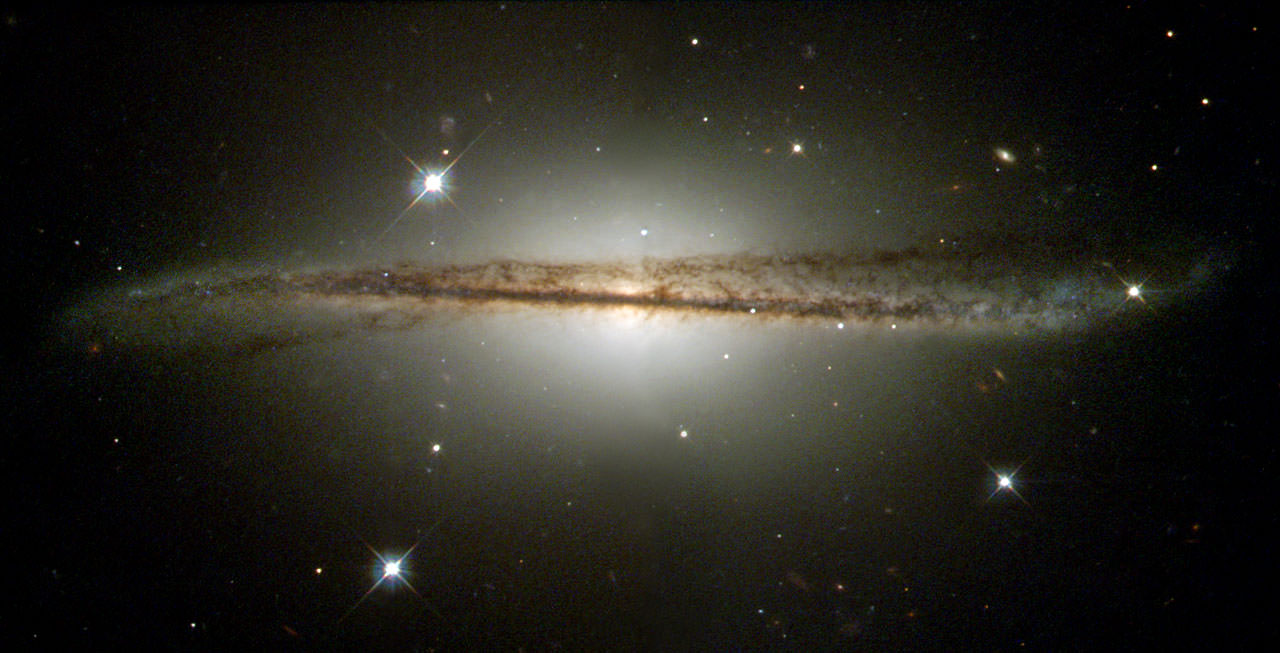[/caption]
This is an older image from Hubble but I came across it today and wanted to share it. It shows an unusual edge-on galaxy, that has been twisted by a recent collision with a nearby galaxy, and is in the process of being swallowed up. This could be a spiral sister to our own Milky Way, as the dust and arms of normal spiral galaxies appear flat when viewed edge-on. And the twisting effect could be an example of what could happen to our galaxy in about 3 billion years when it begins to collide with the Andromeda galaxy.
As the gravitational forces distort the structures of the galaxies as their stars, gas, and dust merge together, it also sparks star formation. In the outer regions of ESO 510-G13, especially on the right-hand side of the image, the twisted disk contains not only dark dust, but also bright clouds of new, blue stars.
Eventually, in millions of years, all the matter will coalesce and the activity and disturbances will die out, and ESO 510-G13 will become a normal-looking single galaxy.
This galaxy was first observed by ESO’s ground based telescopes, and Hubble’s Wide Field Planetary Camera 2 (WFPC2) observed ESO 510-G13 in April 2001.


How can galaxy’s collide if they are all flying away from each other?
Finer point is that if the image shows collision, two galaxies must have been about the same size. It collided almost in plain to each other. There for the center of each galaxies must have approached quite close to each other. What happened when super massive black hole come that close? There needs to be massive fire works! Is there an evidence for that?
How can galaxy’s collide if they are all flying away from each other?
That is only when movement caused by the gravitational pull is bigger than the expansion speed. Basically close-by galaxy’s gets pulled more than the get time to get expanded.
The strength of gravity is stronger than the expansion of the universe (for objects gravitationally bound to one another). For example, you don’t see the moon speeding away from the Earth do you? Same goes for Andromeda and the Milky Way.
For your second point. The ‘twist’ you see isn’t the colliding galaxies, but rather the gravitational effects on ESO 510-G13 from the galaxy it is swallowing up. So I would guess that the colliding galaxy is significantly smaller than ESO 510-G13. Also, when two black holes collide, the bigger one will usually just swallow the smaller one and create one bigger black hole.. So no massive fireworks. (But hey, there are new baby stars forming from the collision)
I think it just looks like a small piece of double-helix DNA.
You say this is an example of an “unusual edge-on galaxy, that has been twisted by a recent collision with a nearby galaxy,” But is it? There is dubious evidence of any swallowed companion galaxy, and paper on this object say doubts too.
An alternative explanation is some kind of perturbation by other galaxies around it. This one could have been isolated from a larger collection of a cluster of galaxies (billions of years ago) moving in some different direction, whose independent velocities simply has distorted the outer disk. It is just the oscillations made on the outer disk by this much older disturbance that makes the warp. (I tried this once on a simple computer galaxy interaction program, and it generated such warps readily given enough time.)
It is clear, regardless if this alternative theory were true, that we are yet to fully understand the process of galaxy formation and all the kinds of possible interaction scenarios.
Even the Milky Way is warped a little bit due to the interaction with the Magellanic Clouds. However, the effect is small for our galaxy, and, IIRC, only the hydrogen “envelope” further out from the stars is actually warped.
Still a nice picture!
If DM makes up 75% of gravitationally bound clusters, wouldn’t it play a good part in the morphing of visible matter objects in the clusters?
I think this galaxy look like it’s rotation has has just been sped up or slowed down rapidly. It might also have suffered a massive rapid contraction, which set up this speed wobble. Think of the wobble of a spinning top as it slows down to stop or the high speed wobble when the top is thrown, before it slows to a smooth balanced rotation. Probably something to do with the massive black hole in the center. I would guess that it is speeding up and creating more stars. Does anyone know if this galaxy has a pulsar-type beam above and below the plane of the galaxy that can be seen in a different electromagnetic spectrum? A “galactic pulsar?” Speeding up or slowing down? I would call it the “Speed-wobble galaxy” or perhaps the “potato chip galaxy.”
Thanks for the interesting photos.
Chris Landau
ESO 510-G13 is in Hydra @ -26Deg 55m 4.3s, -26D 46′ 50″, V mag. 13.4
Thanxs Aqua
You can also read all the data in the “NASA/IPAC Extragalactic Database”, and just type in the object name; http://nedwww.ipac.caltech.edu/forms/byname.html
(More information than you can poke a stick at!)
Eso 510-G13 is in Hydra, the water snake, which is rather an elongated constellation! It stretches from below Cancer past Leo and Virgo and ending up under Libra! That’s quite a haul! As a result, Eso 510-G13 has some rather auspicious company… so many neighborhoods! Which include: NGC 2775 a large spiral galaxy, NGC 3115 The Spindle Galaxy, NGC 3242 a planetary called ‘The Ghost of Jupiter’, M68 a Globular cluster and M83 a face on spiral galaxy. The problem is, it can take a whole night to em all!
“…NGC 3242 a planetary called ‘The Ghost of Jupiter’…”
Ah! Truly one of my favs….
Almost needs the sunnies!
Ahem….’see em all!’